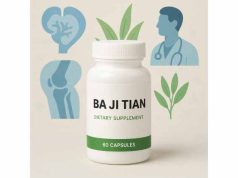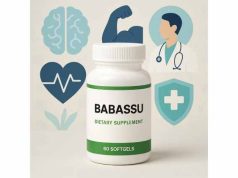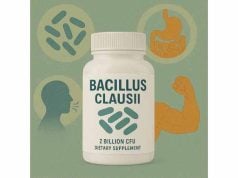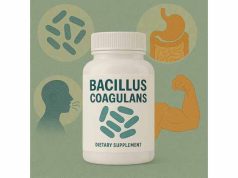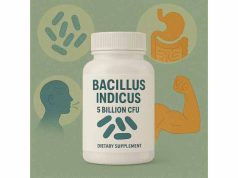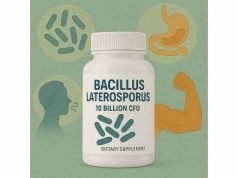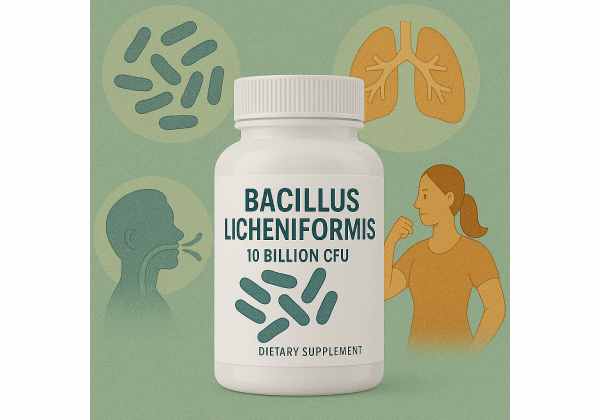
Bacillus licheniformis is an advanced, spore-forming probiotic widely recognized for its resilience and versatile health benefits. This remarkable bacterium not only supports gut health and immune function but is also prized for its enzyme production, aiding in nutrient absorption and digestive comfort. As a probiotic, Bacillus licheniformis stands out for surviving harsh stomach conditions, making it an excellent addition to digestive and wellness routines. Whether you’re looking to enhance your gut microbiome, improve regularity, or boost your immune system, this supplement offers a science-backed solution for modern health challenges.
Key Takeaways
- Survives Harsh Digestive Conditions: Its spore-forming ability ensures it reaches the intestines alive for maximum benefit.
- Supports Digestive Health and Nutrient Absorption: Produces enzymes that help break down proteins, fats, and carbohydrates.
- Strengthens Immune Function: Modulates immune responses and may reduce susceptibility to infections.
- Generally Well Tolerated: Most people experience minimal side effects when used at recommended doses.
- Broad Application: Used for gut balance, digestive comfort, and as part of multi-strain probiotic supplements.
Table of Contents
- Introduction to Bacillus licheniformis and Its Probiotic Significance
- How Bacillus licheniformis Works: Scientific Mechanisms and Biological Effects
- Proven Benefits and Key Uses of Bacillus licheniformis Supplements
- Comprehensive Safety Review and Potential Side Effects of Bacillus licheniformis
- Optimal Dosage, Administration, and Usage Guidelines for Bacillus licheniformis
- Bacillus licheniformis Frequently Asked Questions
Introduction to Bacillus licheniformis and Its Probiotic Significance
Bacillus licheniformis is a resilient bacterium found in soil, water, and even some fermented foods. As a spore-forming probiotic, it distinguishes itself by its ability to withstand environmental extremes and reach the human gut intact. Unlike more fragile probiotic species, Bacillus licheniformis endures manufacturing processes, room temperature storage, and the harsh acidity of the stomach, ensuring that it arrives alive in the intestines to deliver its benefits.
Unique Features and Historical Use
- Spore Formation: The hallmark of Bacillus licheniformis is its durable spore coat, which enables it to lie dormant until it encounters the right conditions in the gastrointestinal tract.
- Enzyme Production: This bacterium produces a variety of digestive enzymes—including proteases, amylases, and lipases—supporting the body’s breakdown of proteins, carbohydrates, and fats.
- Traditional and Modern Applications: While not a staple of traditional fermented foods like yogurt, Bacillus licheniformis has long been used in fermentation and food processing due to its potent enzyme activity. Today, it’s a star ingredient in next-generation probiotic and digestive health formulas.
What Sets Bacillus licheniformis Apart?
- Resilience: Unlike classic probiotics, it survives both the stomach’s acidity and high temperatures during manufacturing and storage.
- Wide Environmental Presence: Its ability to thrive in diverse conditions has made it a research focus for applications ranging from food preservation to agricultural biocontrol.
- Safety and Efficacy: Clinical and laboratory data support its use as a safe, well-tolerated supplement for gut and immune health.
Supplement Forms and Availability
- Capsules: Most common, either as a single-strain product or in combination with other probiotics.
- Powders: For mixing into beverages or food, often found in digestive enzyme blends.
- Functional Foods: Increasingly used in gut-health bars, snacks, and drinks.
Who Might Benefit?
- Those with irregular digestion, bloating, or nutrient absorption concerns
- Individuals recovering from antibiotics or gut disturbances
- People interested in immune support or advanced gut health protocols
- Those with dietary intolerances seeking enzyme assistance
Summary Table: Bacillus licheniformis Overview
| Feature | Details |
|---|---|
| Type | Spore-forming probiotic |
| Key Strength | Survives digestive tract, produces enzymes |
| Benefits | Digestive comfort, immune modulation |
| Common Forms | Capsules, powders, blends |
| Unique Fact | Used in food industry for natural fermentation |
Bacillus licheniformis exemplifies the power and versatility of spore-based probiotics, delivering reliable support for a healthy gut and robust immune system.
How Bacillus licheniformis Works: Scientific Mechanisms and Biological Effects
Understanding the mechanisms behind Bacillus licheniformis’ benefits helps explain why it’s become a popular choice in the probiotic world. Its unique biology and metabolic capabilities set it apart from many standard probiotic species.
1. Spore Formation and Survival
- Acid and Heat Resistance: The spore coat shields Bacillus licheniformis from the stomach’s acidity, bile salts, and even high temperatures encountered during manufacturing and storage.
- Germination in the Gut: Upon reaching the intestines, environmental cues trigger the spores to “germinate” and become metabolically active, where they can colonize and exert beneficial effects.
2. Enzyme Production and Nutrient Support
- Digestive Enzymes: Bacillus licheniformis is renowned for its ability to produce proteases, lipases, and amylases—enzymes that help break down proteins, fats, and carbohydrates. This enhances nutrient absorption and reduces digestive discomfort.
- Biofilm Disruption: The enzymes may also assist in breaking down biofilms (protective layers produced by undesirable microbes), supporting a balanced microbiome.
3. Competitive Exclusion and Microbial Balance
- Crowds Out Pathogens: By occupying space on the gut lining and competing for nutrients, Bacillus licheniformis helps limit the growth of harmful bacteria and yeast.
- Supports Diversity: Promotes a more diverse and stable gut environment, which is linked to better health outcomes.
4. Immune Modulation
- Enhances Immune Responses: This bacterium can interact with gut-associated lymphoid tissue (GALT), stimulating the production of protective molecules and supporting the body’s first line of defense.
- Balances Inflammation: Helps regulate immune signaling, promoting a balanced, non-overreactive immune system.
5. Antimicrobial Activity
- Production of Antimicrobial Substances: Bacillus licheniformis can produce natural compounds (such as lichenicidin) that help inhibit unwanted bacteria, adding another layer of gut protection.
6. Environmental Adaptability
- Its resilience in diverse environments contributes to its stability and effectiveness, both as a supplement and in food applications.
Summary Table: Mechanisms of Bacillus licheniformis
| Mechanism | Benefit |
|---|---|
| Spore resilience | Survives digestion and storage |
| Enzyme production | Aids digestion, breaks down food and biofilms |
| Pathogen exclusion | Limits growth of harmful microbes |
| Immune modulation | Supports balanced immune function |
| Antimicrobial compounds | Provides additional gut defense |
Bacillus licheniformis offers a multi-faceted approach to health, delivering digestive, immune, and protective benefits right where you need them.
Proven Benefits and Key Uses of Bacillus licheniformis Supplements
The science-backed applications of Bacillus licheniformis extend far beyond basic digestion. Let’s explore the leading benefits and real-world uses of this versatile probiotic.
1. Enhanced Digestive Health and Comfort
- Reduces Bloating and Gas: By improving breakdown of foods and reducing fermentation by less desirable bacteria, many users experience less bloating and abdominal discomfort.
- Promotes Regularity: Supports normal bowel movements and reduces symptoms of occasional constipation or loose stools.
- Eases Digestive Intolerances: Enzyme production can help people with mild lactose or gluten sensitivities digest these foods more easily.
2. Improved Nutrient Absorption
- The digestive enzymes produced by Bacillus licheniformis boost the bioavailability of proteins, fats, and carbohydrates, helping your body extract more nutrition from each meal.
3. Gut Microbiome Rebalancing
- Restores Balance After Antibiotics: Effective at replenishing the microbiome after antibiotic use or illness, outcompeting undesirable bacteria.
- Synergy with Other Strains: Works particularly well in multi-strain formulas with other spore-formers (like Bacillus subtilis or Bacillus coagulans) and lactic acid bacteria.
4. Immune System Enhancement
- Supports Innate Immunity: Stimulates the activity of immune cells within the gut, bolstering your defenses against pathogens.
- Reduces Risk of Infections: May help lower the incidence of gastrointestinal and respiratory infections, particularly in at-risk populations.
5. Potential for Cleansing and Detoxification
- Biofilm and Pathogen Disruption: Can be used in gut cleansing protocols, thanks to its ability to break down protective layers and crowd out harmful organisms.
6. Broad Suitability
- Gentle on Sensitive Systems: Its low production of lactic acid and histamine makes it a good option for those sensitive to other probiotics.
- Suitable for Daily Use: Can be taken long-term for ongoing gut and immune support.
Summary Table: Bacillus licheniformis Benefits
| Benefit Area | Evidence-Based Effects |
|---|---|
| Digestive Comfort | Reduces bloating, promotes regularity |
| Nutrient Absorption | Enhances digestion of proteins, fats, carbohydrates |
| Gut Balance | Supports microbiome recovery and diversity |
| Immune Function | Stimulates protective immune responses |
| Sensitive Users | Gentle, low risk of intolerance |
Whether you’re seeking daily digestive support, recovery after antibiotics, or advanced gut cleansing, Bacillus licheniformis is a reliable, well-tolerated choice.
Comprehensive Safety Review and Potential Side Effects of Bacillus licheniformis
Bacillus licheniformis is celebrated for its exceptional safety, especially when used as a probiotic supplement in healthy adults and children. As with any live microorganism or dietary supplement, however, understanding the complete safety profile is important for making informed decisions and optimizing your wellness journey.
1. General Safety and Regulatory Status
- Generally Recognized as Safe (GRAS): Bacillus licheniformis is recognized as safe by food and health authorities in multiple countries, including the United States, when used as directed in food and supplement applications.
- Decades of Use: Its long track record in fermentation, enzyme production, and probiotic supplements supports a strong safety record, with very few reports of serious adverse events in healthy individuals.
2. Mild and Temporary Side Effects
Most people tolerate Bacillus licheniformis very well. However, as your gut microbiome adjusts—especially during the first week or two—minor, transient side effects may occur:
- Mild bloating or increased gas
- Slight changes in bowel movement frequency or consistency
- Temporary abdominal gurgling or mild cramping
These symptoms generally fade as the body adapts and the microbiome becomes more balanced. Starting with a lower dose and increasing gradually can help minimize discomfort.
3. Rare and Serious Reactions
Serious adverse reactions to Bacillus licheniformis are extremely rare, but caution is always warranted:
- Allergic Reactions: Although rare, some individuals may be sensitive to probiotic components. Discontinue use if you notice rash, itching, swelling, or breathing difficulty.
- Infections in Vulnerable Groups: There are isolated reports of infections in severely immunocompromised individuals. Such cases are exceedingly uncommon and usually involve high-dose or hospital settings. If you have a compromised immune system or chronic illness, consult your healthcare provider before starting any probiotic.
4. Special Considerations for At-Risk Populations
- Immunocompromised Individuals: People with weakened immune defenses (due to cancer, organ transplants, or advanced HIV) should only use Bacillus licheniformis under close medical supervision.
- Pregnant and Breastfeeding Women: No adverse outcomes have been reported, but as with any supplement, consult your physician before use during pregnancy or lactation.
- Children: Safe for use in age-appropriate dosages. Follow pediatric recommendations and watch for any unusual digestive symptoms.
5. Drug and Supplement Interactions
- Medications: Bacillus licheniformis is not known to interact negatively with antibiotics or common medications. Its spore-forming structure means it can be taken during and after antibiotic courses to help restore balance.
- Other Supplements: Compatible with most prebiotics, enzymes, and probiotics. If starting multiple new supplements, introduce one at a time to identify any sensitivities.
6. Product Quality and Contamination Risks
Choosing high-quality, third-party-tested brands ensures safety and effectiveness. Poor manufacturing practices—not the probiotic itself—are the usual culprits in the rare event of contamination or lack of efficacy.
7. Best Practices for Safe Use
- Begin with the lowest recommended dose, especially if new to probiotics.
- Observe for any persistent symptoms beyond two weeks.
- Seek medical attention for severe reactions or if you are immunocompromised and develop infection symptoms.
Summary Table: Bacillus licheniformis Safety
| Safety Aspect | Guidance |
|---|---|
| Common Side Effects | Mild bloating, gas, or stool changes (transient) |
| Severe Reactions | Rare; seek help if allergic or severely ill |
| Immunocompromised Use | Only with medical supervision |
| Drug Interactions | None significant |
| Pregnant/Breastfeeding | Generally safe; consult physician |
| Children | Use age-appropriate dosing |
| Product Quality | Select trusted, third-party-verified brands |
In summary, Bacillus licheniformis is among the safest probiotic options for most people when sourced from reputable brands and taken as directed.
Optimal Dosage, Administration, and Usage Guidelines for Bacillus licheniformis
Getting the most from Bacillus licheniformis depends on the correct dosage, consistent use, and integration into a healthy lifestyle. Here’s how to maximize the benefits while keeping safety and convenience in mind.
1. Standard Dosage Recommendations
- Adults: The typical range is 1–5 billion CFU (colony-forming units) per day, either as a standalone supplement or in a multi-strain formula. Some therapeutic blends may contain higher amounts, but more is not always better—follow product labels.
- Children: Pediatric probiotics with Bacillus licheniformis usually contain 250 million to 2 billion CFU. Always follow the manufacturer’s dosing instructions for age and weight.
2. How and When to Take
- With or Without Food: Its spore-forming nature allows you to take Bacillus licheniformis at any time—before, during, or after meals.
- Capsules and Powders: Swallow capsules whole or mix powder into cold foods and beverages. Avoid hot liquids, as high temperatures can reduce probiotic viability.
- Travel and Storage: No refrigeration is required, making it travel-friendly and ideal for busy lifestyles.
3. Duration and Frequency
- Short-Term Use: Beneficial during and after antibiotic treatment, times of digestive upset, or while traveling.
- Long-Term Use: Safe for continuous, daily supplementation for ongoing gut and immune support.
4. Combining with Other Supplements
- Bacillus licheniformis works synergistically with other spore-based and lactic acid probiotics, as well as prebiotics (fiber).
- Start with a single supplement before adding others to allow your body to adjust and track any changes in digestion.
5. Flexibility and Missed Doses
- If you miss a dose, simply resume as soon as you remember; do not double up.
- Consistency is more important than perfect timing.
6. Practical Usage Tips
- Hydrate well and eat a balanced, fiber-rich diet for optimal microbiome support.
- Track changes in digestion, mood, and energy to gauge effectiveness.
- Consult a healthcare provider for personalized advice, especially for children or if you have complex health conditions.
Summary Table: Bacillus licheniformis Dosage & Use
| User Group | Daily Dose | Administration | Storage/Notes |
|---|---|---|---|
| Adults | 1–5 billion CFU | Capsule or powder | No refrigeration needed |
| Children | 250M–2B CFU | Age-appropriate form | Follow pediatric guidance |
| Special Cases | 1–5 billion CFU | Flexible timing | Great for travel/lifestyle |
Personalizing your approach and using high-quality products will yield the best results from Bacillus licheniformis supplementation.
Bacillus licheniformis Frequently Asked Questions
What are the main benefits of Bacillus licheniformis?
Bacillus licheniformis supports gut health, digestive comfort, and immune function. It produces enzymes that enhance nutrient absorption and is resilient enough to survive stomach acid, making it an effective probiotic for daily use.
Is Bacillus licheniformis safe for everyday supplementation?
Yes, Bacillus licheniformis is considered very safe for most adults and children, with rare, mild side effects such as temporary bloating or gas. Those with weakened immune systems should consult a healthcare provider first.
Can Bacillus licheniformis be taken with antibiotics?
Absolutely. Its spore form allows it to survive antibiotic treatment, helping to restore a balanced microbiome during and after antibiotic use.
How much Bacillus licheniformis should I take per day?
Typical adult dosages range from 1–5 billion CFU per day, while children may take 250 million to 2 billion CFU. Always follow label instructions or your healthcare provider’s recommendations.
Does Bacillus licheniformis need to be refrigerated?
No, this spore-forming probiotic is shelf-stable and does not require refrigeration. Store it in a cool, dry place for optimal potency.
Can Bacillus licheniformis help with food intolerances?
Yes, it produces enzymes that help break down problematic foods, such as lactose and gluten, making it useful for mild intolerances and digestive sensitivities.
Are there any drug or supplement interactions?
Bacillus licheniformis is not known to interact with medications or most supplements. If you are immunocompromised or on multiple medications, consult your healthcare provider before starting.
Disclaimer:
This article is for educational purposes only and should not be considered a substitute for medical advice. Always consult your healthcare provider before starting any new supplement, especially if you have a health condition or take medications.
If you found this article helpful, please share it on Facebook, X (formerly Twitter), or any platform you prefer. Follow us on social media to stay updated, and help us keep producing quality content by sharing this guide with others!

